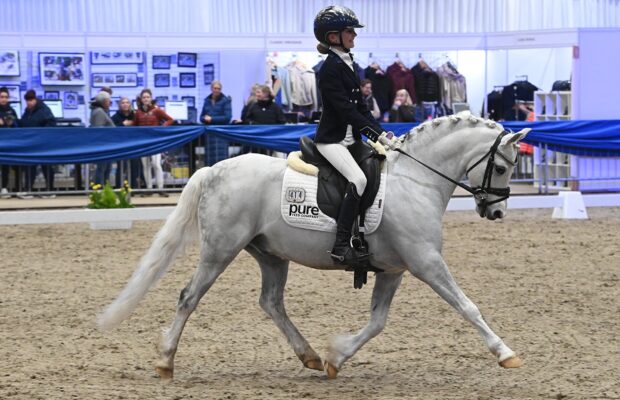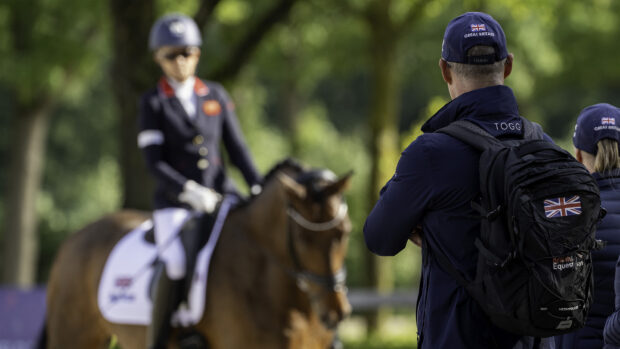The Olympic dressage silver medallist shares three simple dressage exercises to help improve the rideability of the horse, giving the rider control, confidence and calmness
Dressage exercise 1: shoulder-fore
The aim:
To bring the inside hindleg under the horse and build his strength. It enables the rider to gain and keep control of the shoulder and position the hindleg. To achieve shoulder-fore, the horse has to be focused and confident in his rider and less concerned about his surroundings.
I like to feel that I’m never more than 10 strides from being able to put the horse into a shoulder-fore position wherever I am in the school, whether that’s a circle, straight or diagonal line.
The exercise:
- Bring the horse’s shoulder slightly to the inside. The horse’s inside hindleg is positioned on an imaginary line running between the front legs and his head is positioned in the middle of his chest. I like to try and keep the horse’s neck fairly straight. Technically there should be a degree of bend through the whole horse but when you are teaching it to a young horse (or an older one who is unfamiliar with it) it’s easier to grasp the concept if you initially keep everything quite simple, in black and white.
- I usually do this exercise in trot. You can start it in walk to learn the positioning but you need to make sure you refresh the horse off the leg and don’t allow them to become numb to it.
- I do the exercise away from the wall to make sure the rider appreciates that to ride it correctly, the horse needs to be listening to both the rider’s legs.
- The rider’s outside leg is playing a supporting role to keep the horse drifting to the outside and the inside leg is maintaining forwardness. Some horses will need or prefer the rider’s inside leg a little bit behind the girth and outside leg on the girth and others will prefer the reverse. I don’t think there’s a set rule. You need to adapt your aids to what you are trying to achieve.
- Use the turn onto your line, where you will already have the horse bending round the corner, to establish the shoulder-fore position. Once your horse knows it, a good exercise is to arrive onto your line and go straight for a few steps, before asking for the shoulder-fore and then straighten before the end of the school.
Dressage exercise 2: using corners for confidence
The aim:
Horses often find corners scary and will spook away from them. I use these two exercises to gain control of the horse’s body and get them to focus on the rider.
The exercises:
- The first exercise is to ride a 15m or 10m circle in trot in the corner of the school, maintaining a consistent degree of bend throughout.
- The inside hind foot should land in the print of the inside front foot.
- If the horse is spooking at trot, come back to walk and regroup.
- Start with a 15m circle and spiral into 10m.
- Go round the school and ride a circle in each corner, change the rein and repeat.
- An extension of this exercise is to do a circle in the corner after the long side of the school and then to ride shoulder-fore on the short side.
- The second corner exercise is to trot towards the corner and make a transition to walk, make the turn and then trot again. As the horse progresses you can vary how far you go into the corner.
Like this? You might also enjoy reading these:
25 signs you’re an incurable dressage diva/divo
9 dressage questions you’ve been meaning to ask your trainer
Dressage exercise 3: improving the canter transition
The aim:
Correctly ridden transitions teach the horse to balance and to bring his hindquarters under him. Because the horse is pushing from behind, the quality of the transition and the paces that follow improve. I see a lot of horses ignoring the rider’s canter aid and as a result the transition is muddled. The aid for canter needs to be quick and direct, but not so big you shock the horse into canter.
The exercise:
- Ride a 20m trot circle in rising, then go sitting for a quarter of the circle and then go rising for half a circle, then sitting for another quarter before back to rising.
- What you are looking for is that nothing changes in the connection, rhythm, frame and direction. The horse should accept the rider’s seat and weight and then be soft through the back in the transition.
- Once this is established, then go sitting for a quarter of the circle and ask for canter.
- Once in canter and preparing for trot, the rider’s job is to put the horse in the best possible balance and my aid for trot is to balance the canter and then basically stop riding the canter. I always use my voice in the downward transition.
- Repeat the exercise on the other rein, starting with the trotting and sitting around the circle before asking for canter.
In Horse & Hound magazine (13 October 2016), Spencer offers a step-by-step guide to creating more impulsion



